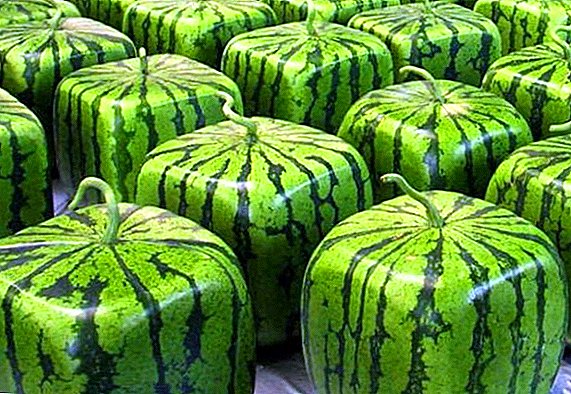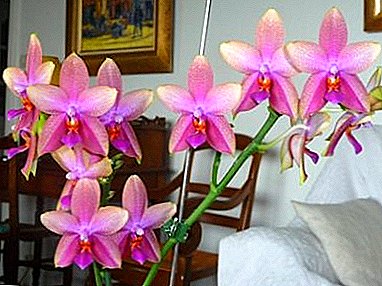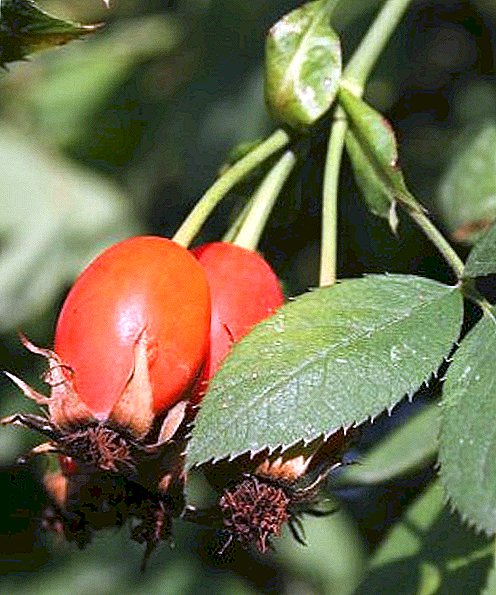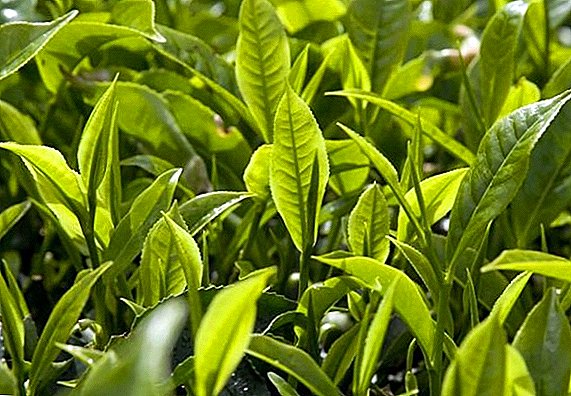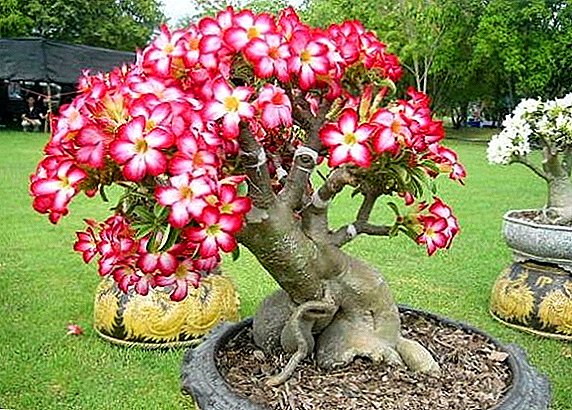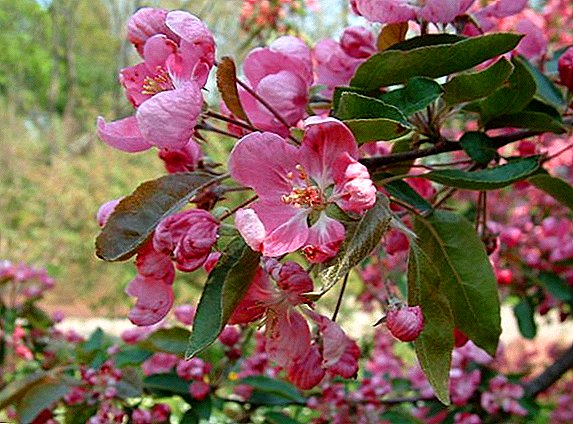 Typically, a variety of exotic plants are used in landscape design. However, with no less pleasure, the site design masters use in their work quite familiar cultures for these latitudes, except perhaps a little modified. A special place among them is occupied by ornamental apple trees. The variety of their types today gives a real scope for creativity. A small fruit tree "Ola" can be an ideal decoration for any landscape composition.
Typically, a variety of exotic plants are used in landscape design. However, with no less pleasure, the site design masters use in their work quite familiar cultures for these latitudes, except perhaps a little modified. A special place among them is occupied by ornamental apple trees. The variety of their types today gives a real scope for creativity. A small fruit tree "Ola" can be an ideal decoration for any landscape composition.
Let's talk about it in more detail.
Description and features
This neat tracery tree got into our region from Poland. In height it is not more than 5 m, decorative round sprawling crown is about the same diameter (however, it can be formed at your discretion). The leaves of this apple tree are a real riot of colors. Dissolving in spring, they have a bright rich color of milk chocolate, in the summer they get a glossy green tint, cast in gold, in the autumn they turn yellow or brown.  During the flowering period, "Ola" is completely covered with huge delicate dark pink flowers, exuding a magical aroma, and by the autumn it is also densely decorated with small, up to 3 cm in diameter, round red apples that do not fall down until the winter.
During the flowering period, "Ola" is completely covered with huge delicate dark pink flowers, exuding a magical aroma, and by the autumn it is also densely decorated with small, up to 3 cm in diameter, round red apples that do not fall down until the winter.
Did you know? "Hola" (pronounced "Ola") in Spain is an easy and relaxed friendly greeting, but from the Polish language "ho-la" can be translated as "wow!", "Wow!", "Ah-ah-ah" . We will not argue exactly what the name of an ornamental apple has, but it's nice to think that this is something exceptionally good and positive, like the tree itself.
Such extraordinary external data suggests that "Ola" is perhaps the most beautiful decorative apple tree known to date, and it is impossible to say when the tree is better - when it is flowering or when it bears fruit. In both the one and the other period, the beauty of this apple tree is simply beyond description.
Application
The main function of the apple "Ola" is, of course, the decoration of the site. This tree is amazingly beautiful in itself, however, with certain knowledge and skills in the field of landscape design, it is also possible to create a wide variety of compositions with its participation.
Important! Ornamental apple trees are often used in landscape design to give the site a Japanese style. In terms of refinement, delicacy and the fragrance “Ola” distributed during flowering, it is not inferior to the classic Japanese sakura, which, unfortunately, does not always take root in unusual conditions, while the wild apple is completely unpretentious.
"Apple trees in bloom - what a miracle." This line from the Soviet song performed by E. Martynov with reference to "Ola" can be multiplied many times. Even the most unfortunate composition with a blossoming apple tree of this sort turns into a refined and luxurious one. And if there is a reservoir close to the tree, in the glare of which the branches covered with bright color can be reflected, such a picture of any summer resident will make an artist or a poet.  The Polish ornamental tree looks very good among evergreens, diluting with its bright colors some dull and monotonous needles. Favorable apple tree looks also in the front part of the yard or near the fence. It can be planted among other fruit trees or fruit bushes and formed at its discretion so that the composition acquires a complete and sophisticated style.
The Polish ornamental tree looks very good among evergreens, diluting with its bright colors some dull and monotonous needles. Favorable apple tree looks also in the front part of the yard or near the fence. It can be planted among other fruit trees or fruit bushes and formed at its discretion so that the composition acquires a complete and sophisticated style.
If on your site there is a corner set aside for a green lawn, on such a clearing a decorative tree will look just great. Another option is to place it in the center of a flower bed among tulips, daffodils, peonies and other spring flowers. Even exquisite roses will benefit from such a neighborhood.
To decorate the site with beautiful flowers, even more trees are planted - sakura, delonix, wisteria, rhododendrons, cerceses, magnolias, lilacs, pyranths, jacaranda.
 In addition, designers love to use ornamental apple trees as hedges. Perfectly succumbing to the cutting and the formation of the crown, such trees alone or together with other perennials are excellent material for the realization of creative imagination.
In addition, designers love to use ornamental apple trees as hedges. Perfectly succumbing to the cutting and the formation of the crown, such trees alone or together with other perennials are excellent material for the realization of creative imagination.
Compositions can be formed, guided by different criteria themselves - by growth, by flowering time and fruiting, by coloring, etc. Knowing the characteristics of all plants used in the design, it is possible to achieve that during the season one exquisite picture will be replaced by another, no less artistic and colorful.
By the way, if you do not have your own land, do not despair! You can plant an ornamental apple tree under your windows, right in the courtyard of an apartment building, and none of the neighbors will definitely express displeasure, quite the contrary.
Interestingly, "Ola" even in winter does not lose its appeal. Paradise apples, remaining on the tree, complement the exposed area with bright red spots, and still attract with their appetizing type of birds, which in frosty days can only please. Covered with frost, these fruits create an amazing atmosphere of peace, tranquility and peace.
But not only for the sake of beauty can this small openwork tree serve.
Important! Experts recommend that you always have at least one decorative apple tree on the site, and this is not only aesthetic. The fact is that such trees due to the strongest aroma during flowering attract a huge number of insects to the site and thus greatly improve the pollination of other fruit trees. In Europe, the presence of wild (ornamental) apples among cultivated fruit trees is a generally accepted agrotechnical device.
Before planting an ornamental apple, especially in small areas, the owners have a reasonable question: are its fruits edible? Such an interest is easy to understand, because every six hundred square meters of roads is on every square meter, and, in addition to beauty, I want to receive practical benefits from the land.
In this regard, "Ola" - a great way to combine business with pleasure. Of course, in terms of taste, its fruits cannot be compared with high-grade fruit apple varieties, however, in a processed form, these paradise apples will delight you. 
Did you know? Paradise apples are called the small fruits of ornamental apple trees. Many legends, myths, sayings and symbols are associated with this tree. In some part it is connected with the shape of the fruit, because the ball is a symbol of perfection. One of the attributes of the absolute power of the monarch is called "power", or "power apple", and means that its owner holds the whole world in his hands. At the same time, the state symbolizes peace, while the scepter symbolizes war.
By the way, this is one of the advantages of the variety. Its fruits, though small, are nevertheless larger than that of most decorative apple trees and really taste quite pleasant.
Selection of seedlings when buying
Unfortunately, fraud in the sale of seeds and seedlings today is a common thing. According to some information, up to ¾ of what is sold over the Internet is a fake. But if you bought the seeds of sweet yellow cherry tomatoes, and the tasteless tomato of the collective farm “harvesting fruitful” variety grew - this is half the trouble. Harvest, make conclusions and next year you will be more cautious.
Worse, when under the guise of valuable grapes, fruit, or, in our case, ornamental trees, an ordinary wilderness is acquired. Such a fake is not immediately found, by this time you have already invested a huge amount of labor and love in the plant, it began, took its place on the site, and it turns out that this is not what you were looking for. Trees live for a very long time, sometimes longer than people, so the choice of a seedling must be approached with all the responsibility: most likely, you plant it once and for the rest of your life (at least, your own).
Trees live for a very long time, sometimes longer than people, so the choice of a seedling must be approached with all the responsibility: most likely, you plant it once and for the rest of your life (at least, your own).
Did you know? Apple - the English word for apple comes from the name Apollo, because in Ancient Greece it was the sacred tree that was dedicated to the ancient Greek god of the sun and wisdom. The ancients associated with the apple, respectively, knowledge and sunshine, and later this attitude towards the fruits only strengthened, because the alchemists saw a five-pointed star, a pentagram, in the apple section.
So, not to be trapped when choosing a sapling, you should follow a number of rules.
The first. Make sure the "Ola" is suitable for your climate. Since this variety was bred in Europe, it was not originally intended for such severe winters, which are, for example, in certain regions of Russia. Today, for the convenience of farmers, the world is divided into several zones of frost resistance, differing from each other in terms of minimum annual temperatures and used precisely to determine the optimal growing conditions for various crops (mainly ornamental and fruit perennials). 
Important! Apple "Ola" refers to the fifth zone of frost resistance. To put it simply, this means that it can grow and develop normally in regions where the maximum values of the thermometer in winter do not drop to -28 ° C. If it is colder in your region, and not on average, but at least sometimes, even if not every year, it is better not to risk starting an ornament on your site such as “Ola”. The above temperature indicator for this apple is a kind of “point of no return”.
For example: the north-western part of Russia is in the fourth zone of frost resistance, Ola is not suitable for this territory, but the whole territory of Ukraine is the fifth, sixth and seventh zones, that is, you can plant an ornamental apple tree in any region.
The second. Do not buy a sapling from the hands of incomprehensible people. Use the services of specialized stores. Even if you trust online commerce, when you receive the goods before you complete the purchase, carefully consider the young tree. It should have a fresh look, without any signs of wilting and drying. The trunk, root neck, wood and leaves are clean and solid, no traces of disease or exposure to pests. The presence of problems is indicated by spots on the leaves, dry wood, cracks, damage to the bark or its peeling, necrosis, wrinkling, brown spots and, especially, mold on any parts of the seedling.  The place of vaccination should be well viewed, moreover, you must make sure that the upper part of the seedling with sprigs and leaflets really is scion (sometimes it happens that under the guise of an elite seedling, an unscrupulous manufacturer sells wild after an unsuccessful vaccination. For self-control, carefully compare the appearance of buds or leaves the sapling offered to you with the neighbors of the same variety).
The place of vaccination should be well viewed, moreover, you must make sure that the upper part of the seedling with sprigs and leaflets really is scion (sometimes it happens that under the guise of an elite seedling, an unscrupulous manufacturer sells wild after an unsuccessful vaccination. For self-control, carefully compare the appearance of buds or leaves the sapling offered to you with the neighbors of the same variety).
Popular varieties of ornamental apple trees are Rudolph, Royalty, Nezvetsky.Third. A tag with complete information about the product and manufacturer should be attached to the seedling: variety, cultivation area, breeder, seller. If there is no such information, initially there will be no one to make a complaint to you, which means you should definitely give up the purchase. By the way, the best place to buy is the nursery itself, there the probability of acquiring a fake tends to zero, and finding the “ends” if you are deceived is much easier: such an organization is unlikely to disappear somewhere.
Another consideration: if the nursery is in your region and sells an apple tree of this variety, it means that it is suitable for your climate, moreover, it was originally grown in it. Buying a seedling from a local producer is an additional guarantee of successful tree growth. Fourth. A seedling sold in earthen coma is, of course, good for a tree, less stress from transplanting. However, in the land of unscrupulous manufacturers often try to disguise problems with the root system. Open roots must be intact, otherwise the integrity of the manufacturer and the professionalism can not cause confidence. A healthy seedling has bright roots, and the heart is the same light (do not be too lazy to check the cut). On the roots there can be no spots, growths and other signs of the disease.
Fourth. A seedling sold in earthen coma is, of course, good for a tree, less stress from transplanting. However, in the land of unscrupulous manufacturers often try to disguise problems with the root system. Open roots must be intact, otherwise the integrity of the manufacturer and the professionalism can not cause confidence. A healthy seedling has bright roots, and the heart is the same light (do not be too lazy to check the cut). On the roots there can be no spots, growths and other signs of the disease.
Important! Nodular growths on the roots - the symptoms of root cancer!
The core root of an apple-tree must have at least 3 main branches about 30 cm long. It is very important that the open root be properly packed: covered with a material that absorbs moisture well. This is a standard requirement; if it is not met, then the rest of the seller cannot be trusted.  However, if you make a purchase via the Internet, or a sapling is brought from a distance, or you are not going to plant it immediately - a tree with open roots will not work for you. By the way, it is also better not to buy a sapling with leaves, because through them a young tree loses moisture, dries quickly and then takes a very hard root. A self-respecting producer prunes the leaves of a sapling before selling, without affecting the stem. If you are going to plant an apple tree in the spring, buy a seedling with unopened buds.
However, if you make a purchase via the Internet, or a sapling is brought from a distance, or you are not going to plant it immediately - a tree with open roots will not work for you. By the way, it is also better not to buy a sapling with leaves, because through them a young tree loses moisture, dries quickly and then takes a very hard root. A self-respecting producer prunes the leaves of a sapling before selling, without affecting the stem. If you are going to plant an apple tree in the spring, buy a seedling with unopened buds.
Important! When purchasing a seedling with open roots, immediately wrap them in a plastic bag with a small amount of water. Plant such a tree should be as soon as possible. The maximum permissible storage period is 10 days in cool conditions (up to 10 ° C), but you cannot know for sure how much of this period has already passed since the tree was dug out of the ground.
If the seedling is sold with closed roots, the strength of its roots can also be checked. Make sure that the earth lump is sufficiently dense and "native" (a good sign is the presence of moss on the surface), and the seedling does not fall out of the ground or out of the container in which it is located.  The fifth. It is best to buy a one-year, maximum two-year-old sapling, not older, because the younger the tree, the easier it endures the tremendous stress associated with transplanting. By the way, the height of the “same trees” should be a little more than 1 m (plus 20-30 cm), “two-year-olds” - about 1.5 m. If the tree is smaller, this means that the proper conditions were not provided for it and you should not buy it.
The fifth. It is best to buy a one-year, maximum two-year-old sapling, not older, because the younger the tree, the easier it endures the tremendous stress associated with transplanting. By the way, the height of the “same trees” should be a little more than 1 m (plus 20-30 cm), “two-year-olds” - about 1.5 m. If the tree is smaller, this means that the proper conditions were not provided for it and you should not buy it.
The lack of a crown in an annual sapling is normal, but the older plant should already have sprouts evenly directed in all directions. The age of a tree is easily determined by the characteristic flows on the bark, they are formed annually.
The sixth. Always buy seedlings just before planting, never do this in advance, because the storage of young trees requires certain conditions and can not last long. Another mistake - the acquisition of young trees in the early fairs, at the end of winter or early spring. During this period, planting material from the southern regions, poorly suited for a more severe climate, is thrown into the market.
Once again: the best option is a local nursery, where you yourself (or with the help of a specialist) will choose a tree for your taste, after which you will be dug out of the ground right in front of you. 
Planting seedlings of ornamental apple
Planting and caring for the Ola apple tree are, by and large, the same as for ordinary fruit apple trees; moreover, unlike the latter, the ornamental tree can forgive some mistakes of an inexperienced gardener. But in order for it to truly delight the eye over the years, it is better to do everything at once “according to science”.
Choosing a place
This variety of ornamental apple makes quite high demands on the soil. The land should be very fertile, light (it is good to pass air) and rather damp. At the same time, the tree does not tolerate water stagnation at all; therefore, too high groundwater should not pass nearby, or water should be arranged before planting.
The optimal distance to other trees should be at least 4-5 meters.
When choosing a place for an ornamental tree, it is also necessary to take into account that it may feel good in the penumbra, however it blooms especially beautifully and beautifully in sunny areas, and the shadow does not like at all. Since it is for the beautiful flowering of "Ola" that is valued above all, the right choice for such a tree is very important.
Optimal timing
Traditionally, garden trees are planted in early spring, until the buds have blossomed, or in mid-autumn, after the trees have dropped foliage. It is believed that if the sapling is grown in a container, it can be planted using the transshipment method in open ground at any time in spring, autumn or summer.
Nevertheless, experts recommend still prefer autumn planting of apple trees, and here's why.
In spring, when nature comes to life, the rapid growth of the aerial part of trees begins: buds bloom, leaves and flowers appear, new shoots are formed. The root system, which has not yet strengthened, is simply unable to feed this "riot of life" and at the same time take care of itself, that is, to provide, so to speak, a foundation.
As a result, it very often happens that the tree that was planted in the spring seemed to be beautifully taken, the whole summer pleased you with young twigs and foliage, by autumn, as usual, the leaves turned yellow and fell off, and the tree did not survive the winter.  In autumn, the process is almost the opposite. The land during planting is still quite warm, but vital juices have already slowed down, it is not necessary to spend forces on the maintenance and development of the above-ground part, and there is still time to fix the roots in the soil before winter. Such a sapling remarkably manages to strengthen and take root, and in the spring, with the beginning of the vegetative period, it will be happy to direct the already accumulated energy to the “outer beauty”.
In autumn, the process is almost the opposite. The land during planting is still quite warm, but vital juices have already slowed down, it is not necessary to spend forces on the maintenance and development of the above-ground part, and there is still time to fix the roots in the soil before winter. Such a sapling remarkably manages to strengthen and take root, and in the spring, with the beginning of the vegetative period, it will be happy to direct the already accumulated energy to the “outer beauty”.
Important! Choosing an autumn planting, you at least win a whole year, because from next spring you will have a fully planted seedling, while with a spring planting in a year, the tree will only begin to recover after the first very hard winter. In the worst case, when planting in the spring, your seemingly settled seedling risks not going through the winter at all.
In addition, the tree that was planted in the fall gradually and systematically leaves during the cold hibernation period. At this time, he is not disturbed by any disease or pests, since the period of their active life activity has already been completed. In the spring, the apple tree that survived the transplant stress almost immediately faces the full scale of difficulties and troubles: from spring floods or late frosts to unthinkable heat, dryness, and parasites that are starved after winter. 
Step-by-step process
Everyone understands that planting a tree begins with a pit, but few know that such a pit needs to be prepared in advance and very carefully.
Important! A good gardener begins to “equip” a pit for a future apple tree for six months, or even a year before planting, the seedling.
In order for the tree to start and develop well in the future, the soil must be thoroughly decontaminated and saturated with all the nutrients that the future plant needs. Subsequent feeding, of course, is important, but the groundwork for the first 2 years of the tree’s life is done during the preparation of the planting pit.
If you decide to plant an apple tree in the fall, engage the pit for at least a month and a half, if in the spring, it is desirable to do it the day before in the fall. But when it comes to virgin land, the preparation of land for the garden must begin at least a year.
The dimensions of the pit itself should not be much larger than the earthen coma or the root system of the seedling. However, such a hole can be dug only if you are sure of the fertility of the land on your plot. Ideally, it is still worth digging the soil for 1 cu. m, to fill its volume of the prepared soil mixture.  When preparing the pit, it is necessary to divide the ground extracted from it into 2 parts: the upper fertile layer separately, the lower infertile layer separately. Try to keep the edges of the pit as steep as possible. The last 30-40 cm of land is not extracted from the pit, but simply dug up well. In the presence of high groundwater at the bottom of the pit must be laid drainage layer.
When preparing the pit, it is necessary to divide the ground extracted from it into 2 parts: the upper fertile layer separately, the lower infertile layer separately. Try to keep the edges of the pit as steep as possible. The last 30-40 cm of land is not extracted from the pit, but simply dug up well. In the presence of high groundwater at the bottom of the pit must be laid drainage layer.
Now prepare the nutritional mixture. Its basis is humus or compost, about 20-30 liters, as well as 30-40 liters of peat (peat). To these components, add 500 g of superphosphate, 1.5 kg of phosphate rock (just 1 kg of superphosphate can be taken), as well as 1 kg of wood ash (this organic potash fertilizer can be replaced with mineral, preferably not containing chlorine, for example, potassium sulfate in an amount of 150 g or potassium salt in the same amount).
Important! Nitrogen fertilizers and lime should not be applied to the soil mixture; they will make it difficult for the seedling to survive. It is also impossible to use manure for these purposes, since its evaporation is toxic to the roots of a sapling.
Lay the prepared mixture in the pit so as to fill it with a slide. When the fertile mixture has passed, we will only have to prepare the hole of the required volume (in the amount of the root system of the young apple tree).
Now you can go for a sapling. We have already said how to protect the tree from drying out the roots, but if it did happen, lower the root part of the tree into the water for 24 hours before planting. 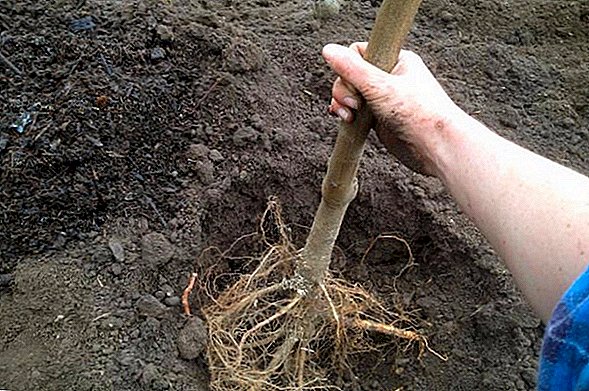 Carefully place the seedling in the prepared pit so that the root neck is not more than 8-10 cm deep into the soil. We fill the pit with fertile soil, dug out of it earlier, we well tamper it and pour it abundantly.
Carefully place the seedling in the prepared pit so that the root neck is not more than 8-10 cm deep into the soil. We fill the pit with fertile soil, dug out of it earlier, we well tamper it and pour it abundantly.
Features of care and cultivation agrotechnics
As already mentioned, you need to take care of an ornamental apple tree in the same way as fruit. The main procedures are watering, weeding, mulching, combating diseases and pests, shaping, as well as proper preparation for winter.
Soil care
"Ola", as already mentioned, loves wet soil, but does not tolerate stagnant water. Usually, starting from the next spring after planting, it is enough to water the tree 3 times per season: in early summer (in spring the moisture in the soil is enough for the apple tree), during the beginning of fruiting and in late autumn, to moisten the soil before winter, so the ground freezes through less. Watering should be carried out around the perimeter of the circle of the trunk (and in an adult tree - along the perimeter of the crown), it is impossible to pour water directly under the root of the tree.
Important! In order not to be mistaken with the dose, follow the "golden rule": the age of an apple tree in years corresponds to a one-time amount of water for watering it in buckets.
 In order not to engage in weeding and loosening and at the same time retain all moisture in the soil, to prevent the possibility of weeds to grow and achieve a more aesthetic appearance, ornamental apple trees usually mulch. As cover, you can use pine needles, sawdust, peat, nutshells and other suitable material that is available.
In order not to engage in weeding and loosening and at the same time retain all moisture in the soil, to prevent the possibility of weeds to grow and achieve a more aesthetic appearance, ornamental apple trees usually mulch. As cover, you can use pine needles, sawdust, peat, nutshells and other suitable material that is available.Top dressing
With proper planting for the first 2 years, we have already provided our apple tree with all the necessary fertilizers. In any case, during the first year after planting, fertilize the tree is not worth it - just water it abundantly and prevent overgrowth of the tree trunk with weeds.
Starting from the second or third year, three times a season, an apple tree needs to be fed. Organic fertilizers, potash and phosphorus additives are applied in the fall, simultaneously with the digging of the trunk.
In the early spring, before the buds have blossomed, nitrogen fertilizers or organic matter containing nitrogen (for example, mullein) are applied. Upon completion of flowering, foliar application (spraying) is recommended in May or early June. Fruiting adult apples are usually fertilized more often, but for the decorative "Ola" such a scheme would be quite enough.
Fruiting adult apples are usually fertilized more often, but for the decorative "Ola" such a scheme would be quite enough.
Fertilizers should be applied to a depth of 15 cm for young seedlings and 45 cm for trees older than three years, around a circle with a radius of 1.5 m, where the center is the base of the trunk.
Preventive spraying
Alas, ornamental apple trees suffer from the same ailments as our usual fruit trees, in particular, their main enemies - scab, powdery mildew, rust, black cancer, cytosporosis, among insects - aphid, ants, leafworm, fruit mite, tick, apple moth .
However, it is necessary to give them their due, these semi-wild trees show greater stability to the main parasites than their more gentle counterparts.
Nevertheless, for prevention in the spring, even before bud break, it is better to treat the apple tree with insecticides and fungicides. Since the fruits of the "Ola" variety are quite suitable for food, it is not worthwhile to poison the pests during flowering and fruiting, moreover, it is better to give preference to modern biological products, they are almost non-toxic and very effective.  The second preventive spraying is carried out in the autumn; its main goal is to destroy those pests that have settled for the winter in the bark or in the soil around the tree. Nitrafen and urea are well suited for this purpose.
The second preventive spraying is carried out in the autumn; its main goal is to destroy those pests that have settled for the winter in the bark or in the soil around the tree. Nitrafen and urea are well suited for this purpose.
Cropping and crown formation
Formation and pruning are essential elements of caring for an ornamental apple tree, because the appearance of the tree and how it fits into the design of our site are of fundamental importance for us.
Did you know? An apple is a fruit known to people since antiquity. In a certain period in Europe, it was even used as a kind of measure. In particular, any overseas wonder first thing compared with an apple: a tomato, for example, was called a golden apple (ital. "ROMI d'oro"), potatoes - damn, tangerines and lemons - respectively, Chinese and Indian, but apples.
There are a lot of ways and methods for the formation of such trees, it all depends on your preferences and ideas of the landscape designer. The most common pattern for the formation of an ornamental apple is as follows.  On a young tree in the spring, pruning of approximately 10 cm of the tip of the largest vertical shoot is carried out so that 6-7 buds remain above the stem. At the edges of the seedling, 3-4 large skeletal branches are selected, growing in different directions, if possible, evenly. These branches are shortened at the same level, and all other "competing" shoots are removed. Ideally, the main vertical branch should remain above the side, and the side - as far as possible from each other.
On a young tree in the spring, pruning of approximately 10 cm of the tip of the largest vertical shoot is carried out so that 6-7 buds remain above the stem. At the edges of the seedling, 3-4 large skeletal branches are selected, growing in different directions, if possible, evenly. These branches are shortened at the same level, and all other "competing" shoots are removed. Ideally, the main vertical branch should remain above the side, and the side - as far as possible from each other.
Each subsequent year, such formative pruning is repeated, only to the 3 initial skeletal branches are added, 2-3 new strongest skeletal shoots, selected in such a way that the tree does not remain one-sided. Weak branches are removed, selected evenly shortened.
With such pruning, the apple tree will grow with a perfectly round crown and always have a neat and well-groomed appearance. 
Preparing for the winter
We have already mentioned above that Ola is a relatively winter-hardy variety. Nevertheless, it must be borne in mind that the climate on the planet is changing, and, which is especially unpleasant, towards unpredictability. Therefore, even in the regions belonging to the fifth and higher zones of winter-hardiness, it does not prevent us from worrying about the preparation for the winter of our ornamental apple trees, especially the young ones.
The fact is that in these, until recently considered warm, regions in recent years, winter temperatures are abrupt, while the length of daylight hours remains generally unchanged. It is the ratio of the length of daylight hours and the minimum temperature that determines the frost resistance zone: having prepared in winter in accordance with the length of the day “befitting” this climate, the plant suddenly finds itself in conditions of abnormally low temperature and in such a situation can really die.
Another condition for easy wintering for a tree is the presence of a large amount of snow. It is snow, not ice. And in this regard, non-constant temperatures in winter also render the apple a bad service. As a result of a sharp and unexpected warming, the fallen snow first begins to melt, then freeze, covering the soil around the trunk with an ice crust that does not allow oxygen to pass through. In such an extreme mode, even not very low temperatures can be very hard for a tree to survive.  Proceeding from this, an ornamental apple tree, until it has finally matured, is strongly recommended to cover for the winter even before the real cold weather has arrived. For these purposes, any material that is commonly used for mulching is suitable - sawdust, needles, straw, dried leaves, peat.
Proceeding from this, an ornamental apple tree, until it has finally matured, is strongly recommended to cover for the winter even before the real cold weather has arrived. For these purposes, any material that is commonly used for mulching is suitable - sawdust, needles, straw, dried leaves, peat.
To protect the trunk from temperature shocks and teeth of small rodents, it is worth wrapping it with burlap or special agrofiber, while avoiding the use of dark-colored materials, otherwise during thaw or just under direct sunlight the bark will begin to rot and even begin to peel off from the wood.
Do not be lazy to conduct such simple preventive measures - and your young tree will adequately endure even an abnormally harsh winter.
To plant an Ola decorative apple tree on your plot is to ensure a great mood for yourself for many years. If someone wants to see envy in the eyes of neighbors - he will get it too. However, in addition to beauty, this amazing openwork tree will increase the yield of all other plants in your garden, attracting bees with the incredible aroma and beauty of large pink flowers, and at the end of summer will enjoy the abundant harvest of paradise apples, from which you can cook wonderful jam for the winter, boiling them whole.


